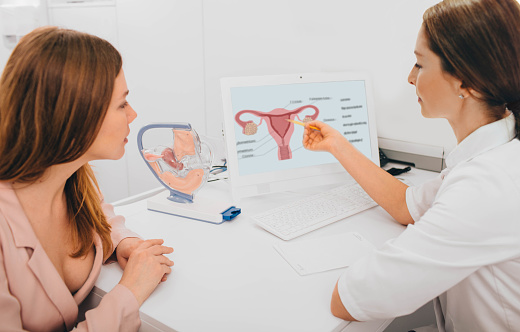
In order to maintain good reproductive and sexual health, females should visit a gynecologist- a doctor who specializes in females’ reproductive health- for an exam about once per year. Generally, females should begin seeing a gynecologist at the age of 21, but begin earlier if they become sexually active. After their first visit, females ages 21 to 29 should visit their gynecologist annually to get a Pap smear. Females between the ages of 30 to 64 should generally visit every other year.1 Other reasons to visit a gynecologist include seeking treatment for irregular periods, sexually transmitted infections (STIs), and vaginal infections. Females who are sexually active or are considering becoming sexually active can visit a gynecologist to learn more about contraceptive methods.
During each exam, the gynecologist typically asks about the female’s sexual history and menstrual cycle. The gynecologist also physically examines the female’s breasts and genitals. Understandably, a visit of this nature can cause some females discomfort. However, periodic gynecological exams are crucial to sexual and reproductive health and should not be skipped. The patient’s anxiety can be significantly decreased if she knows what to expect from the visit. Prepared with the knowledge of what actually occurs during an annual exam, females often find that it can be a straightforward and rewarding experience.
Table of Contents
How to Prepare
Before a gynecological exam, there are several steps that females should take to be prepared:
- Try to schedule an appointment between menstrual periods. Menstrual fluid can interfere with the exam as well as lab tests.
- Do not have vaginal intercourse or insert anything into the vagina, including douches or vaginal products, for at least 24 hours before the visit. Sexual activity may irritate the vaginal tissue and increase the chance of incorrect Pap test results.
- It is a good idea to prepare a list of any questions and concerns for your gynecologist prior to the appointment. Your gynecologist needs to know about any irregular vaginal bleeding, discharge, odor, or pain.
- The gynecologist will ask about your menstrual cycle, so it will be helpful to know the date your last period started and how long your periods usually last.3
What to Expect

At the beginning of the visit, a nurse will record some basic measurements such as weight, blood pressure, and date of the start of your last menstrual period. Before the exam begins, you will be given a paper or cloth gown and privacy to undress.
A gynecological exam can include discussions about personal and family medical history, sexual history, safe sex an alternative contraceptive options. Appointments are also a great time for you to address any questions you may have, including questions about irregular periods, vaginal discharge, STIs, and pregnancy tests.1
It is perfectly normal to feel nervous about the breast and pelvic exams, since they focus on private areas of the body. However, try not to worry! These exams are routine procedures for the physician, and many females are often surprised and relieved to find out that the breast and pelvic exams are quick and relatively painless.
The Breast Exam
The purpose of the breast exam is to check for any lumps or irregularities in the breast tissue. The doctor examines the female’s breasts by making gentle circular and linear motions with his/her fingers. It should feel as if the doctor is massaging your breasts and only last about a minute. If you feel discomfort or pain while the doctor is feeling your breasts, be sure to the doctor know. The doctor may also show you how to perform a breast self-exam, because it is important to check for lumps or irregularities between gynecological visits. If you are over the age of 35, the gynecologist may recommend mammogram screening for breast cancer.1

The Pelvic Exam
The pelvic exam consists of the doctor inspecting the female’s external and internal genitalia. Try to urinate before the exam because it may feel uncomfortable with a full bladder. During this exam, the female lies down on the exam table and places her feet on the footrests to keep her knees apart. The pelvic exam can go much more easily and smoothly if the female remains relaxed, and the exam should only last five minutes. A drape cloth that can be rested over the hips and thighs for coverage may be provided.
Here are some things that you can expect during a pelvic exam:
- The doctor will examine the vulva (exterior genitalia) to check for signs of irritation, infection, or sores.
- The doctor will insert a lubricated speculum into the vagina. A speculum (shown right) is a thin metal device that resembles the shape of a duckbill. The closed speculum is inserted into the vagina and then slowly opened to separate the vaginal walls. This provides the gynecologist with a view of the vaginal wall and cervix. If your muscles are relaxed, the speculum should only cause a slight amount of pressure. Slight discomfort is common, but be sure to let your gynecologist know if you are experiencing considerable pain.
- The physician will swipe the cervical mucus with a cotton swab to collect a sample of cervical cells. This procedure is called a Pap smear. Pap smears are used to detect the presence of abnormalities that can be caused by cervical cancer, vaginal infections, or STIs.
- The doctor will manually examine the reproductive organs. Wearing latex gloves, the doctor will insert one or two lubricated fingers into the vagina, and press on the lower abdomen with the other hand, in order to physically feel the female’s internal reproductive organs. This procedure checks the size, shape, and position of the uterus, which can affect fertility and the type of contraception that should be used. It also checks for swelling or tenderness in the vagina and reproductive organs. These may be signs of an infection, pregnancy, or cysts. As with the other components of the pelvic exam, this procedure should be quick and cause only mild pressure or discomfort. If you experience pain at any point in the exam, be sure to let your doctor know!1,3
- Your gynecologist may also insert a gloved finger into the rectum to check for abnormalities behind the uterus, vaginal wall, or rectum.4
After the gynecologist has completed the physical examination, there will be a final opportunity to discuss with your doctor any other additional questions or concerns you may have. Your gynecologist is an honest and trustworthy source of information, so do not be embarrassed to ask about any topics relating to your sexual health. Doctors must abide by strict confidentiality agreements, so any information you share will remain private. Regular visits to the gynecologist are vital to ensure and maintain optimal sexual health.
References
- “Pelvic Exam.” Planned Parenthood. N.p., 2014. Web.
- “Gynecological (GYN) Visits.” Brown University. N.p., n.d. Web.
- Cornforth, Tracee. “What Happens During an Annual Pap Test and Pelvic Exam?” About Women’s Health. N.p., 19 June 2014. Web.
- “Why Do Gynecologists Do Rectal Exams?.” KnowsWhy. 26 August 2010. Web.
Last Updated: 21 August 2014.
